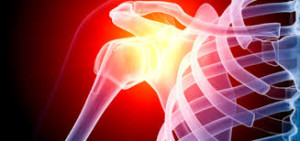Stroke Shoulder Pain and Stiffness
NeuroRehab Team
Tuesday, March 22nd, 2016
Arm and HandshoulderStroke StatisticsSubluxation Slings

Shoulder pain is a common complication after stroke. Up to 72% of stroke patients develop hemiplegic shoulder pain. It may occur in up to 80% of stroke patients who have little or no voluntary movement of the affected upper limb. Painful stroke shoulder can negatively affect rehab outcomes as adequate shoulder function is a prerequisite for hand function, ADL’s, and functional mobility.
Shoulder subluxation, spasticity, impingement, soft tissue trauma, rotator cuff tears, capsulitis, tendinitis, and shoulder hand syndrome are just a few of the reasons why one may suffer from a painful hemiplegic shoulder. Frozen shoulder, also known as adhesive capsulitis, may be one of the most significant causes of shoulder pain after stroke. Frozen shoulder can be observed in up to 77% of patients suffering from shoulder pain.
What is Frozen Shoulder?
Frozen shoulder is the common name for adhesive capsulitis, which is a shoulder condition that limits your range of motion. When the tissues in your shoulder joint become inflammed and stiff, scar tissue develops over time. As a result, your shoulder joint doesn’t have enough space to rotate properly. Common symptoms include swelling, pain, and stiffness.
Key Facts:
- Frozen shoulder is one of the most significant causes of shoulder pain after stroke. Bohannon, R. Arch Phys Med Rehabil, 1986.
- 66% of hemiplegic shoulder pain patients exhibit reduced external rotation range of motion. Wanklyn, P. Disabil Rehabil, 1996.
- Shoulder pathology occurs in up to 85% of patients with spastic symptoms and 18% of patients with flaccid symptoms (Van Ounwnaller).
- Frozen shoulder can occur as early as 2 weeks post stroke, 2-3 months is more typical (poduri).
Stage of Frozen Shoulder:
- Freezing (Painful) Stage (2-9 months): gradual development of severe shoulder pain – worse at night with increasing stiffness. Typically pain precedes the restriction of movement, but in some instances, loss of range of motion may be the first symptom.
- Frozen (Stiffness) Stage (4-12 months): severe loss of motion with decreasing pain. Joint capsule thickens and adheres itself to the humeral head.
- Thawing Stage (5-26 months): gradual return of range of motion.
(Reeves, 1975)
Treatment:
Therapy is the most common treatment for a frozen shoulder. The goal is to stretch your shoulder joint and regain the lost motion. It can take anywhere from a few weeks to months or years to see progress. Non-invasive treatment interventions to address a painful and stiff shoulder may include passive stretching, active/resistive exercises, manual therapy, electrical stimulation, mirror therapy, taping/strapping, proper positioning and medications.
Search Products for Shoulder Stiffness
Search Products for Shoulder Strengthening
Search Products for Shoulder Subluxation
A painful and stiff shoulder following a stroke is a challenging condition for both the therapist and patient. It is important for clinicians to make an accurate and early diagnosis in order address the concerns soon after onset.
Neurorehabdirectory.com does not endorse any products found on this website.
Terms and Conditions | Privacy Policy

